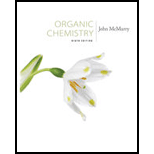
Concept explainers
a) CH5
Interpretation:
The reason for the non-existence of an organic molecule with molecular formula CH5 is to be stated.
Concept introduction:
The number of covalent bonds formed by an atom is determined by its valence electrons to be shared for attaining the nearest noble gas configuration.
To determine:
The reason for the non-existence of an organic molecule with molecular formula CH5.
b) C2H6N
Interpretation:
The reason for the non-existence of an organic molecule with molecular formula C2H6N is to be stated.
Concept introduction:
The number of covalent bonds formed by an atom is determined by its valence electrons to be shared for attaining the nearest noble gas configuration.
To determine:
The reason for the non-existence of an organic molecule with molecular formula C2H6N.
c) C3H5Br2
Interpretation:
The reason for the non-existence of an organic molecule with molecular formula C3H5Br2 is to be stated.
Concept introduction:
The number of covalent bonds formed by an atom is determined by its valence electrons to be shared for attaining the nearest noble gas configuration.
To determine:
The reason for the non-existence of an organic molecule with molecular formula C3H5Br2.
Trending nowThis is a popular solution!

Chapter 1 Solutions
Organic Chemistry - With Access (Custom)
- Hi, I need your help i dont know which one to draw please. I’ve attached the question along with my lab instructions. Please use the reaction from the lab only, as we are not allowed to use outside sources. Thank you!arrow_forward5. Write the formation reaction of the following complex compounds from the following reactants: 6. AgNO₃ + K₂CrO₂ + NH₄OH → 7. HgNO₃ + excess KI → 8. Al(NO₃)₃ + excess NaOH →arrow_forwardIndicate whether the product formed in the reaction exhibits tautomerism. If so, draw the structure of the tautomers. CO₂C2H5 + CH3-NH-NH,arrow_forward
- Draw the major product of this reaction N-(cyclohex-1-en-1-yl)-1-(pyrrolidino) reacts with CH2=CHCHO, heat, H3O+arrow_forwardDraw the starting material that would be needed to make this product through an intramolecular Dieckmann reactionarrow_forwardDraw the major product of this reaction. Nitropropane reacts + pent-3-en-2-one reacts with NaOCH2CH3, CH3CHOHarrow_forward
- Indicate whether the product formed in the reaction exhibits tautomerism. If so, draw the structure of the tautomers. OC2H5 + CoHs-NH-NH,arrow_forwardExplain how substitutions at the 5-position of barbituric acid increase the compound's lipophilicity.arrow_forwardExplain how substitutions at the 5-position of phenobarbital increase the compound's lipophilicity.arrow_forward
- Name an interesting derivative of barbituric acid, describing its structure.arrow_forwardBriefly describe the synthesis mechanism of barbituric acid from the condensation of urea with a β-diketone.arrow_forwardGiven the hydrazones indicated, draw the structures of the enamines that can be formed. Indicate the most stable enamine (explain). C6H5 C6H5 H C6H5 Harrow_forward
 Chemistry: The Molecular ScienceChemistryISBN:9781285199047Author:John W. Moore, Conrad L. StanitskiPublisher:Cengage Learning
Chemistry: The Molecular ScienceChemistryISBN:9781285199047Author:John W. Moore, Conrad L. StanitskiPublisher:Cengage Learning
